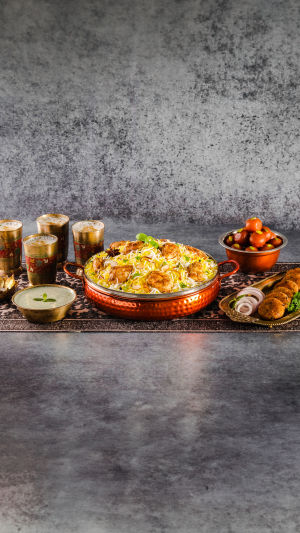Lykkers, get ready to dive into one of the most vibrant and flavorful cuisines in the world! Indian cooking is more than just food—it's a lively celebration of color, aroma, and tradition.
Every dish tells a story, shaped by local ingredients, unique methods, and time-honored recipes. With each bite, you're tasting centuries of culture and creativity. Let’s explore the magic of Indian food together!
<h3>Regional Variety Across the Country</h3>
<b>North India: Rich and Aromatic</b>
The northern regions of India offer hearty meals full of flavor. Popular dishes include biryani—fragrant rice with spices—along with creamy curries and dishes like paneer tikka, which uses a type of Indian cheese marinated in spices and grilled.
<b>South India: Light and Flavorful</b>
Southern states are known for rice-based dishes such as dosa (thin crepes made from fermented rice and lentils), idli (steamed cakes), and sambar (a tangy lentil stew). These dishes are often paired with coconut-based chutneys and are packed with layers of flavor.
<b>West and Central India: A Fusion of Flavors</b>
In the west, you'll find the savory poha from Maharashtra and the colorful thali platters of Gujarat, which offer small portions of various dishes served together. Central India brings you dishes like dal bafla—lentils served with wheat dumplings.
<b>East India: Subtle and Delicate Tastes</b>
This region focuses on freshwater fish, mustard seeds, and lightly spiced stews. Delicacies such as fish curry, served with rice, are staples here.
<h3>The Magic of Indian Spices</h3>
<b>Commonly Used Spices</b>
Indian cuisine is famous for its use of spices that create layers of aroma and taste.
Key spices include cumin (for a warm, earthy base), coriander (fresh and citrusy), turmeric (vivid and healing), chili (for heat), ginger (sharp and pungent), cardamom (sweet and aromatic), and cinnamon (warm and comforting).
<b>Custom Blends and Signature Flavors</b>
These spices are often mixed to create specific blends, such as garam masala or curry powder. Each mix is unique, crafted with care to complement the ingredients in each dish.
<h3>Traditional Cooking Techniques</h3>
<b>Tandoor: Open-Flame Cooking</b>
This high-heat method involves baking or grilling in a cylindrical clay oven. It’s used to make flatbreads like naan, as well as marinated vegetables and cheeses.
<b>Curry-Style Cooking</b>
Vegetables, lentils, or proteins are simmered in richly seasoned sauces, often made from a base of onions, tomatoes, and spice mixtures. These dishes are comforting and full of depth.
<b>Bhuna: Slow-Cooked Intensity</b>
This involves gently roasting spices and ingredients in oil to concentrate flavor. It’s a technique that enhances both aroma and richness.
<b>Pakora: Savory Fried Snacks</b>
Bites of vegetables are coated in seasoned gram flour and lightly fried, resulting in crispy snacks that are often enjoyed with dipping sauces.
<h3>Plant-Based and Seafood Delights</h3>
<b>Vegetarian Selections</b>
Indian meals offer a large variety of plant-based dishes. Popular choices include chana masala (spiced chickpeas), palak paneer (spinach with paneer), and vegetable curries filled with potatoes, peas, and cauliflower.
<b>Seafood Highlights</b>
Coastal regions are known for dishes using fish and prawns, prepared with spices, tamarind, or coconut-based sauces, bringing freshness and zest to every bite.
<h3>Street Food Favorites</h3>
<b>Quick Snacks with Big Flavor</b>
Indian street food is an exciting mix of textures and tastes. From crispy samosas to spiced potato-filled vada pav and tangy golgappa, there’s something for everyone. These treats are found at bustling markets and are often made fresh on the spot.
<h3>Sweets That Steal the Show</h3>
<b>Delightful Treats</b>
Indian desserts often combine dairy, grains, nuts, and spices. Popular choices include gulab jamun (sweet dough balls in syrup), jalebi (spiraled sweets soaked in syrup), rasgulla (syrupy semolina treats), and kulfi (a frozen dessert with pistachio or mango flavors).
<b>Comforting Desserts</b>
Kheer (a rice and milk pudding) and gajar ka halwa (a slow-cooked carrot dessert) are staples during special occasions. These sweets bring a comforting end to any meal.
<h3>Nutritional Advantages</h3>
<b>Spices with Natural Benefits</b>
Many spices used in Indian dishes—like turmeric, chili, and ginger—are known for supporting digestion and reducing discomfort. These ingredients bring both taste and wellness to the table.
<b>Balanced Meals</b>
Indian food often features legumes, vegetables, whole grains, and plant oils, making it a well-rounded diet. The focus on variety ensures a steady supply of essential nutrients, including fiber and vitamins.
<h3>Cooking Tips for Home Kitchens</h3>
<b>Starting at Home</b>
To create authentic Indian dishes, start with fresh spices and herbs. Key items to keep on hand include cumin, coriander, turmeric, ginger, and chili.
<b>Practice the Techniques</b>
Learning the basics—like preparing masala bases and tempering spices—makes it easier to try different recipes. Simple tools like a heavy pan and mortar and pestle can help unlock bold flavors.
<b>Experiment and Adapt</b>
Don’t hesitate to explore and make your own variations. Indian cuisine is versatile, and each recipe can be adjusted to match individual preferences while still remaining true to its roots.
<h3>Conclusion: Savor the Experience, Lykkers!</h3>
Indian cuisine is a delicious adventure, bursting with color, creativity, and culture. From sizzling street snacks to nourishing home-style meals, it offers something for every kind of palate. Enjoying these dishes is not just about taste—it's about discovering stories, traditions, and a shared love for food that brings people together.





